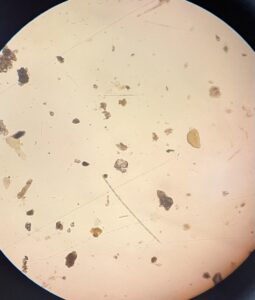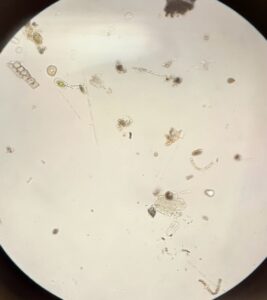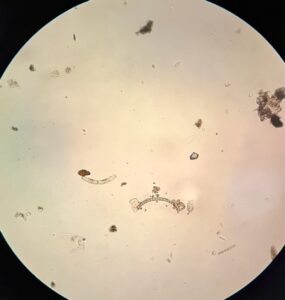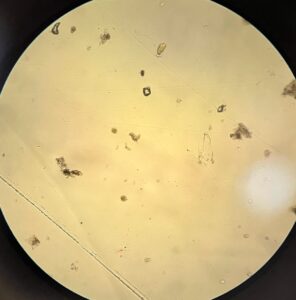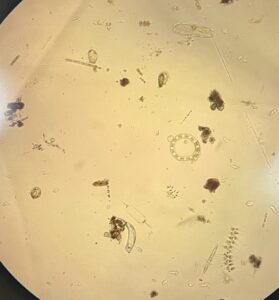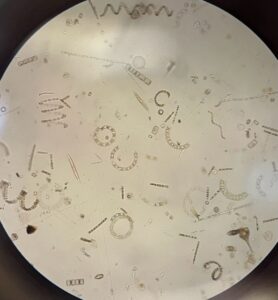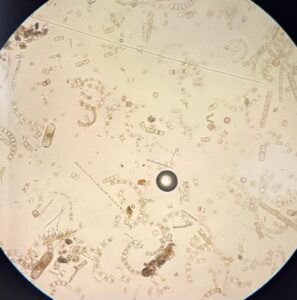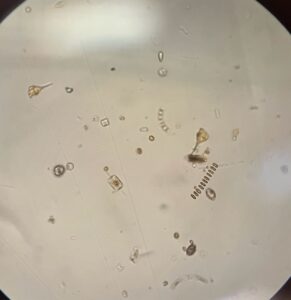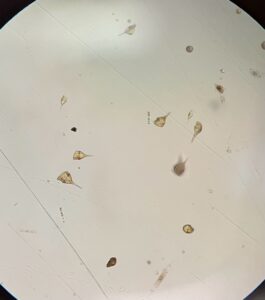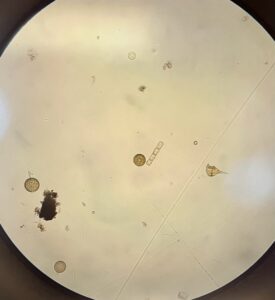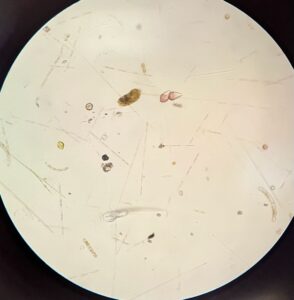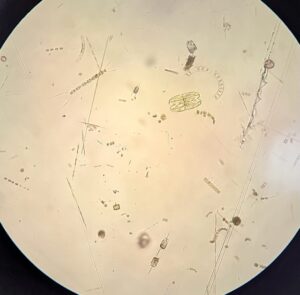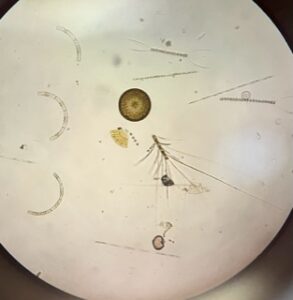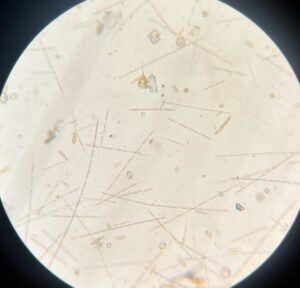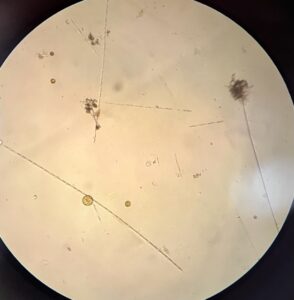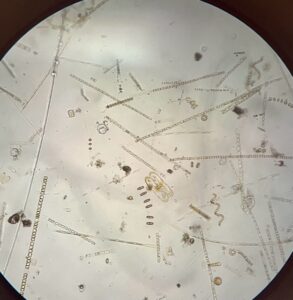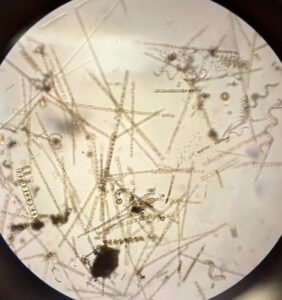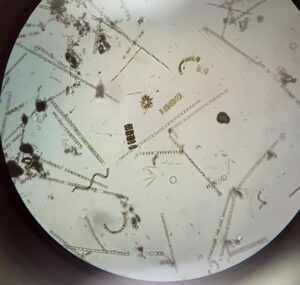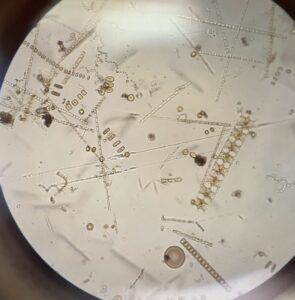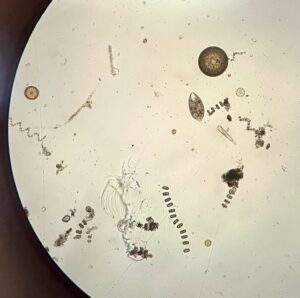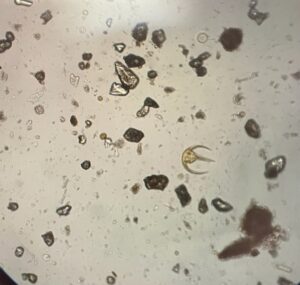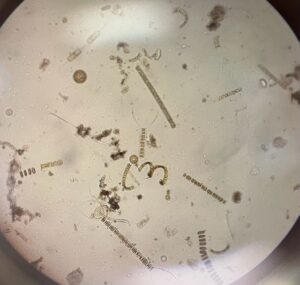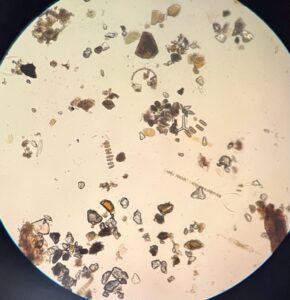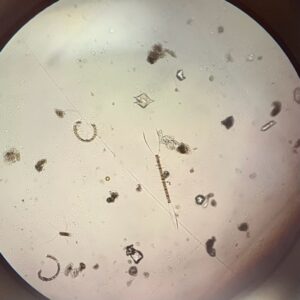Routine monitoring at the Monterey Wharf
Every Wednesday, a member of EBL travels down to the Monterey Commercial Wharf- MWII and collects water samples from phytoplankton net tows and a Van Doren. These water samples are taken back to the lab for analyses which include nutrients, chl-a, RAI, and cell counts. For more information please visit https://habs.sccoos.org/monterey-wharf.
Weekly Updates
Below are some images of phytoplankton we have observed during our weekly RAIs. Descriptions for each sampled week are listed below the gallery.
9.20.2023
The wharf was cloudy this morning. There was no breeze and the surface waters looked calm. The water this week was slightly greener than last week with a visibility of 3.5m. Chlorophyll remained relatively the same from last week. Diatoms dominated the water column. Pseudo-nitzschia was abundant. Meanwhile Chaetoceros and Akashiwo were common in the water. Prorocentrum was present. The HAB species that were observed in the water this morning included Pseudo-nitzschia, Alexandrium, Dinophysis, Cochlodinium, and Akashiwo sanguinea.
9.13.2023
This morning it was misty and cloudy on the wharf. There was a slight breeze in the air. Two sea lion kept me company this morning. The surface of the water had small rolling waves. The water this week was the same color as last week with a visibility of 4.5m. Diatoms dominated the water column. Pseudo-nitzschia was abundant in the water. Meanwhile, Chaetoceros was common in the water. The HAB species that were present in the water this morning included Pseudo-nitzschia, Alexandriu, Dinophysis and Akashiwo sanguinea.
9.6.2023
This morning was cloudy and windy. There were lots of birds and fishermen. The surface of the water had many ripples. The water this week was slightly bluer than last week with the same visibility of 5.0m. Chlorophyll decreased from last week. Diatoms dominated the water column. Chaetoceros and Pseudo-nitzschia were common in the water. Pleurosigma was present in the water. The HAB species that were observed in the water this morning included Pseudo-nitzschia, Alexandrium, Dinophysis and Akashiwo sanguinea.
8.30.2023
The wharf was beautiful (see picture below). There was a breeze on the wharf. This morning there were clear skies and a bright sun. However, the sky in the distance was slightly hazy. The surface of the water had slow rolling waves that moved towards the direction of the dock. The water this week was bluer than last week with the same visibility of 4.5m. Chlorophyll decreased from last week. Dinoflagellates dominated the water column. Prorocentrum and Dictyocha were common in the water column. Meanwhile Pleurosigma was present. The HAB species that were observed in the water this morning included Pseudo-nitzschia, Dinophysis and Akashiwo sanguinea.
8.23.2023
It was a warm morning at the wharf - T-shirt weather has finally reached the central coast! A little too warm (75F!) in the lab while processing samples. The skies were clear, the sun was out, and not a lot of activity (human or animal). Chlorophyll dropped this week - diatoms have been replaced by a lovely array of dinoflagellates, including Akashiwo sanguinea, Dinophysis, Alexandrium, and Cochlodinium.
8.16.2023
Fog-ust has set in. The wharf this morning was very cloudy with a slight breeze. I couldn't see the mountains on the horizon. There were small ripples on the surface of the water. There was also more kelp on the surface of the water than usual. The water smelt stinky this morning when I performed my net tows. The water this week was a slightly lighter green than last week with a visibility of 4.5m. Chlorophyll decreased from last week. Diatoms dominated the water column. Chaetoceros and Asterionellopsis were common in the water. Meanwhile, Eucampia, Pseudo-nitzschia, Cylindrotheca, Dinophysis, and Prorocentrum were present in the water. The HAB species that were observed in the water this morning included Pseudo-nitzschia, Dinophysis, Cochlodinium, and Akashiwo sanguinea.
8.2.2023
The wharf this morning was cloudy and lightly misting. There was no breeze or wind at my sampling site. The surface water was calm. Fog hugged the horizon. Many of the seabirds kept me company this morning. The water this week was slightly greener than last week with a visibility of 3.0m. The Eucampia bloom still persists. Chlorophyll increased from last week. Diatoms dominated the water column. Eucampia was abundant. The HAB species that were present in the water this morning included Pseudo-nitzschia, Alexandrium, and Akashiwo sanguinea.
7.26.2023
Another overcast morning at the wharf, complete with drizzle! “Eucamp” make this up - yes, the Eucampia bloom still persists, with HAB species (Pseudo-nitzschia, Akashiwo, Dinophysis, Cochlodinium) present in very low background concentrations once again. I noted something that looked a lot like Pyrophacus as being common, our resident expert (aka Hannah) will be back next week and can confirm.
7.19.2023
While the rest of the state bakes in the heat, we remain in our cool pocket - puffy vests and a heated car seat were needed on this chilly morning at the wharf after some overnight mist. Surface waters were clean and flat, and the Eucampia bloom from last week persists. Just a smattering of HAB species were present in very very low numbers: Pseudo-nitzschia, Dinophysis, Alexandrium, Cochlodinium, and Akashiwo.
7.12.2023
This morning my site was foggy and misting. The sky was covered with clouds. There were many seabirds flying over my site. On the surface of the water there was debris, kelp, and seabird feathers. The water was smellier than usual. The water this week was a slightly darker green than last week with a visibility of 3.25m. Chlorophyll significantly increased from two weeks ago. Eucampia was abundant. Meanwhile, Lauderia, Ceratium, Prorocentrum, and Noctiluca were present in the water. The HAB species that were observed in the water this morning included Pseudo-nitzschia, Alexandrium, Dinophysis, Cochlodinium, and Akashiwo sanguinea.
7.5.2023
This morning there was a slight breeze on the wharf. The surface water was relatively calm and looked glassy in the distance. Several boats were docked near my site. The sky was filled with clouds. The water this week was a slightly darker green than last week with a visibility of 3.0m. Unfortunately, there was technical difficulty measuring chlorophyll this week ): Species that were common in the water included Ditylum, Thalassiosira, and Cylindrotheca. Species that were present in the water included Eucampia, Guinardia, Prorocentrum, and Ceratium. The HAB species that were observed in the water this morning included Pseudo-nitzschia, Alexandrium, Dinophysis, Cochlodinium, and Akashiwo sanguinea.
6.28.2023
There was a slight breeze on the wharf this morning. The sky was filled with clouds and mist. The water was relatively calm. There were many fishermen at my site. The water this week was greener than last week with a visibility of 3.75m. Chlorophyll significantly increased from last week. Ceratium was abundant. Meanwhile, Ditylum and Prorocentrum were present in the water. The HAB species that were observed in the water this morning included Pseudo-nitzschia, Alexandrium, Dinophysis, Cochlodinium, and Akashiwo sanguinea.
6.14.2023
This morning the wharf was cloudy but the air was relatively warm. The sun was trying to peek through the clouds. There were several sailboats docked at my site. In addition, there were bird feathers on the surface of the water. Overall, the water was relatively calm. The water this week was a slightly lighter green than last week with a visibility of 5.0m. Chlorophyll decreased from last week. Pseudo-nitzschia was abundant in the water. Meanwhile, Chaetoceros, Dinophysis, and Pyrophacus were present. The HAB species that were observed in the water this morning included Pseudo-nitzschia, Alexandrium, and Dinophysis.
6.7.2023
This morning my sampling site was loud from a truck (golden state portables). It was misting on the wharf and the sky was covered in clouds. On the surface of the water, a sea lion was playing with a floating whole small watermelon. There were several boats docked at my site. The water this week was slightly greener than last week with a visibility of 4.5m. Chlorophyll increased from last week. Both Chaetoceros and Pseudo-nitzschia were common in the water. Cylindrotheca and Guinardia were present. The HAB species that were observed in the water this morning included Pseudo-nitzschia, Alexandrium, and Dinophysis.
5.31.2023
This morning the sky was filled with clouds. The mountains in the horizon were slightly visible. There was a slight breeze but the surface water was relatively calm. There were many seabirds flying on the surface of the water. The water this week was greener than last week with a visibility of 5.5m. Chlorophyll slightly decreased from last week. Both Chaetoceros and Pseudo-nitzschia were common in the water. Meanwhile, Guinardia was present. The HAB species that were observed in the water this morning included Pseudo-nitzschia, Alexandrium, Dinophysis, and Akashiwo sanguinea.
5.17.2023
This morning the sky was filled with clouds and it was misting. There was a slight breeze at my site. I was not able to see the mountains in the distance due to the fog. There were large slow rolling waves on the surface of the water moving in the direction towards the wharf. The water this week was a slightly darker green than last week with a visibility of 2.5m. Chlorophyll significantly increased from last week. Pseudo nitzschia was abundant. Navicula was common. Dinophysis was present. The HAB species that were observed in the water this morning included Pseudo nitzschia, Alexandrium, Dinophysis, and Akashiwo sanguinea.
5.10.2023
On my drive to the sampling site it drizzled. This morning it was windy and smelled fishy. The sky was filled with clouds. There was no fog and I could see the horizon clearly. The surface water was wavy. The water this week was bluer than last week with a visibility of 7.0m. Chlorophyll significantly decreased from last week. Diatoms dominated the water column. Pseudo nitzschia was abundant. Tintinnids were common. Species that were present in the water were Chaetoceros and Leptocylindrus. The HAB species that were observed in the water this morning included Pseudo nitzschia, Dinophysis and Akashiwo sanguinea.
5.3.2023
This morning my sampling site was chilly and cloudy. Driving down to the wharf it was drizzling however during sampling it did not rain. The surface of the water was relatively calm and glassy looking in the distance. The sun hid behind the clouds half of the time I was sampling. There were several boats docked and many birds to keep me company. The water this week was slightly greener than last week with a visibility of 3.5m. Chlorophyll increased from last week. Diatoms dominated the water column. Chaetoceros, Pseudo nitzschia, and Skeletonema were common in the water. Meanwhile, Thalassiosira, Detonula, Leptocylindrus, and Asterionollopsis were present in the water. The HAB species that were observed in the water this morning included Pseudo nitzschia and Dinophysis.
4.26.2023
The sky was covered in clouds and misting. Blankets of fog covered the water and horizon. Several boats were docked near my site. There was more bird poop at my sampling site than usual. There was a slight breeze. The surface of the water was relatively calm. The water this week was a darker green than last week with a visibility of 4.0m. Chlorophyll slightly decreased from last week. Skeletonema was abundant in the water. Both Chaetoceros and Pseudo nitzschia were common in the water. Meanwhile, Detonula was present. The HAB species that were observed in the water this morning included Pseudo nitzschia and Dinophysis.
4.19.2023
Sampling this morning was very pleasant. The sky was clear and sunny. In the distance, there was a very slight blanket of haze/fog lining the horizon but you could still see the mountains. Several boats were docked near my site and there was a paddle boarder this morning. The surface of the water was relatively calm with small bubbles on the surface. The water this week was a lighter green than last week with a visibility of 3.5m. Chlorophyll decreased from last week. Both Chaetoceros, Pseudo nitzschia, and Skeletonema were common in the water. Meanwhile, Thalassiosira, Lauderia, and Asterionellopsis were present. The HAB species that were observed in the water this morning included Psuedo nitzschia, Alexandrium, and Dinophysis.
4.12.2023
This morning was sunny but cold and very windy. The birds this morning were keeping me company. There were 5 boats docked near my sampling site. The surface water had lots of waves. In the distance, there were many white caps. In addition, there was fog along the horizon. The water this week was a much darker green than last week with a visibility of 2.0m. Chlorophyll significantly increased from last week. Both Chaetoceros and Asterionellopsis were common. While, Psuedo nitzschia seriata, Lauderia, Thalassiosira, Detonula, and Skeletonema were present in the water. The HAB species that were observed in the water this morning included Psuedo nitzschia and Dinophysis.
4.5.2023
The wharf was sunny and relatively warm. This week, I had a visiting scientist from France join me during sampling. We saw an octopus being eaten by a seabird! There were small waves on the surface of the water. The water this week was greener than last week with a visibility of 2.5m. Chlorophyll stayed relatively the same as last week. Both Thalassiosira and Skeletonema were common in the water. While Asterionellopsis was present in the water. The HAB species that were present in the water this morning included Psuedo nitzschia, AlexandriumandDinophysis.
3.29.2023
There slight breeze on the wharf and the water was murkier than usual. There were also many seabirds and large pieces of plastic floating on the surface of the water. Large rolling waves and swells formed right under the dock. Nearly half of the sky was covered with clouds; dark clouds covered the mountains in the distance. The water this week was much greener than last week with a visibility of 1.25m. Chlorophyll increased from last week. Both Chaetoceros, Psuedo nitzschia and Coscinodiscus were present in the water. Thalassiosira was common in the water. The HAB species that were present in the water this morning included Psuedo nitzschia.
3.22.2023
California lately has been experiencing lots of rain. This morning it was raining heavily at the wharf. The water this week was bluer than two weeks ago with a visibility of 6.5m. Chlorophyll decreased from two weeks ago. Diatoms still dominated the water column. Coscinodiscus was present in the water. The HAB species that were observed in the water this morning included Psuedo nitzschia and Dinophysis.
3.1.2023
This week the water sample was filled with lots sediment. The wharf was very windy (25 mph winds!). The water this week was a slightly darker green than last week with the same visibility of 2.5m. Chlorophyll decreased from last week. Diatoms dominated the water column. Chaetoceros and Thalassiosira were common in the water. The HAB species that were observed in the water this morning included Psuedo nitzschia and Dinophysis.
2.15.2023
This weeks water sample was diverse with diatoms. Chaetoceros (looks like spiny ringlets with hairs) was abundant while Ditylum (looks like a cattail plant) and Lauderia were present. The harmful algae bloom (HAB) species that were present in the water this morning included Psuedo nitzschia, Dinophysis, and A. sanguinea.


